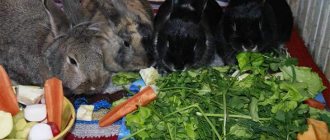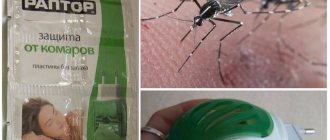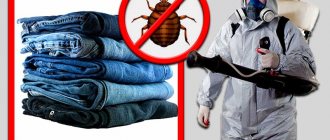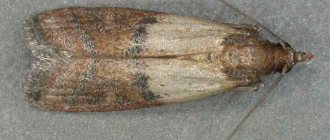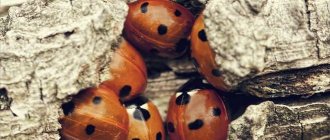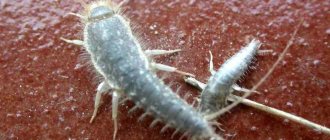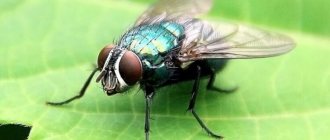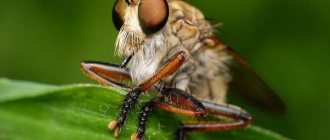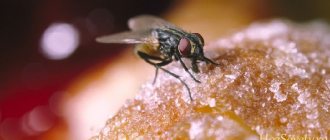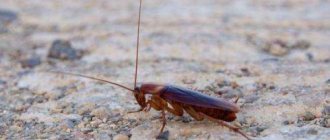What kind of flies can you find in the house?
It has not yet been established exactly how many species of flies live in nature. The family of these dipterans has several hundred species. However, not all of them need proximity to humans. Among them, those living in the wild stand out, but the number of synanthropic species, at the ecological level associated with human settlements, is impressive.
Synanthropus insects pose a potential threat to human health, which is largely due to what the flies eat. According to the nature of food consumption of adults, several groups are distinguished, and in each of them the specific type of nutrition of the adults corresponds to the method of feeding of the larvae.
So, the following groups of these dipterans live near humans:
- Coprophagous - This type feeds on human and animal excrement and food waste. Plant sap is what flies feed on in nature, an additional food resource. The most common species are the grassland Muscidae and the brownie.
- Hematophagous - these dipterans in the adult stage prefer human and animal blood, sweat, blood and ichor oozing from wounds, and the larvae require excrement or decomposing animal remains and plant remains. Common representatives are the market fly and the autumn fly.
- Polyphages are insects that, as adults, feed on human excrement and food, waste, and secretions from wounds and mucous membranes. The housefly is a typical representative of this type.
House flies and house flies are the most common in homes, but pasture flies, market flies, and autumn flies also enter the house. Usually, with the onset of cold weather, insects disappear; an ambient temperature of 23 degrees Celsius is comfortable for their life.
Feeding process in flies
What do flies eat? These dipterans are considered practically omnivorous. And the lack of teeth is not a hindrance. The feeding process involves a long proboscis - a kind of tongue divided into two tubes. It is through them that the food that the fly eats is absorbed.
This is interesting, but without exaggeration these insects can be called gourmets - they do not eat everything. On the paws of an adult individual there are taste buds that allow you to taste food before the proboscis gets involved.
What do flies eat in the house? It is most convenient for insects to eat liquid food, since solid food is more difficult to eat. The indoor snack lover spends too much energy on eating and digesting it: first, solid food is abundantly moistened with saliva, and only then penetrates the digestive tract.
Typically, these dipterans are not capable of sucking human blood, but the mouthparts of the housefly, which is very similar to a housefly, are designed in a special way. The proboscis, strongly elongated and equipped with chitinous “teeth” at the end, scrapes off the epidermis by friction and lets saliva into the puncture. The zhigalka not only feeds on blood, but also leaves irritation at the site of the bite.
What foods do flies prefer?
There is what flies feed on most readily, and there is food that is used only in the absence of the preferred one. Thus, “favorite” foods include sweet foods: jam, compotes, juices, honey, etc. For the larvae to mature, flies need protein food, and here preference is given to meat, fish, etc., especially decomposing and spoiling foods.
Human housing is an ideal “dining room” for flies, and the food here is very varied. They use ready-made dishes that are not protected by lids and packaging, food waste, and when accessing the toilet (relevant for private homes), excrement. And this is not all that flies eat at home. Animal bowls, children's pots with excrement that were not removed in time, rotting fruit - all this also serves as a place for a feast.
Conclusion
And it carries particles of what the housefly eats from feeding places on its paws and proboscis, thus spreading diseases - helminthic, intestinal, infectious. By preventing insects from accessing human food, the risk of many diseases can be reduced.
Studying the “enemy”
A fly is an arthropod insect belonging to the order Diptera. The world population numbers about 3,650 species. The apartments of Russian residents are most often inhabited by house flies, which cannot live far from humans.
Danger
Why do people try to get rid of flies? Because of the annoying buzzing, because of the unpleasant sensations from the movement of flies over the face and body. But insects are also dangerous. They carry diseases on their paws, including:
- typhoid fever;
- typhus;
- cholera;
- salmonellosis;
- tuberculosis;
- dysentery;
- diarrhea;
- conjunctivitis;
- parasitic worms.
Flies lay eggs in food, most often they leave the body in their original form, but in large quantities they can cause intestinal disorders and intoxication.
Houseflies don't bite. But burner flies leave bites. They are distinguished from “apartment” insects by the special structure of their proboscis, which allows them to feed on the blood of animals and only occasionally humans. Mostly such insects live on livestock farms.
Morphological features
The body of an arthropod is divided into three zones: head, chest and abdomen. The size of the dipteran living in the apartment is up to 50 mm. The specific structure of flies determines factors that complicate the fight against them. Let us highlight four features that determine the survivability of insects.
- High speed. The wings allow the insect to move very quickly: the fly can reach speeds of up to 20 km/h.
- Sensitive sense of smell. On the insect's head there is a pair of antennae, consisting of four segments, which allow the arthropod to smell food at a great distance.
- Developed vision. The eyes of the dipteran, consisting of 4 thousand lenses, provide all-round vision. Also on the “top of the head” there are three more eyes looking up - they are only visible under a microscope. The insect reacts very quickly to approaching objects, which is why it is so difficult to catch it. However, the fly cannot distinguish a transparent barrier, so you can often see it unsuccessfully hitting the glass.
- Tenacity. The fly has six legs, “equipped” with claws and thin hairs that allow the insect to cling to the surface, as well as special glands that secrete a sticky substance. That is why a fly can move equally well on horizontal and vertical surfaces, and even upside down on the ceiling.
Why does a fly rub its legs? The sticky secretion secreted by the glands of the paws collects particles of dirt and dust, which significantly reduces the ability to “attach” to surfaces. Therefore, the insect has to periodically clean the pads of its feet by rubbing them against each other.
Life cycle
Flies do not live long - 1.5-2 months. However, during this time the female can lay from 500 to 2000 eggs. The life cycle of an arthropod can be divided into four stages.
- Egg. Typically the insect lays 1.2mm white eggs in humid conditions. As a rule, this is garbage, compost pits, for some varieties - meat, fish, food products.
- Larva. The worm-like larva emerges from the egg after about 8-24 hours. Its development lasts 5-14 days
- Doll. The larva crawls to a dry place and turns into a pupa. Pupation lasts five to six days.
- Adult. An adult insect emerges from the pupa, which after ten days acquires the ability to mate. Flies reproduce at an astonishing rate, laying up to 150 eggs per day.
With the onset of cold weather, adult females and pupae hibernate. They often spend the winter in secluded corners of heated apartments.
Living conditions and nutritional habits
The most favorable temperature for insects is 23-25°C and air humidity 80%. When the temperature drops, the dipterans become lethargic and gradually hibernate. Therefore, in winter the question of how to get flies out of an apartment usually does not arise.
Flies living in an apartment feed on any food of organic origin. They give particular preference to sweets (jam, honey, juices, fruits) and rotting foods. Insects do not have teeth and suck up food with their proboscis, so in order to soften hard food, they pre-treat it with their own saliva.
How they appear
Where do flies come from in the house? Most often, insects fly into an apartment through open windows and doors, and ventilation holes. Fly eggs can be brought into the apartment along with vegetables and fruits and even a bouquet of wild flowers. Most often this happens in summer and autumn - during the period of insect activity, however, even in winter, a sleeping fly or larva can get into the house.
But why don’t insects stay in some apartments, while in others they feel great? The answer is simple: the uncleanliness of the owners is an invitation card for winged “invaders.” A dirty kitchen is the most attractive for insects; there is always something to profit from:
- overflowing trash can;
- food remains on the table and other surfaces;
- piles of dirty dishes;
- pet bowl.
Most often, residents of the first floors suffer from an “invasion” of flies: the proximity of barrels of garbage and a damp basement create a favorable environment for insects.
About other varieties
Sometimes, in addition to indoor flies, other types of flies can settle in an apartment. The table below will introduce you to the characteristics of insects.
Table - Types of flies that can live in an apartment
| Variety | Appearance | Features of existence |
| Drosophila (fruit or fruit midge) | - Red eyes; - body yellow-brown; – size – about 2.5 mm | — Feeds on rotting vegetables and fruits, flower nectar, sour plant juice; — the journey from egg to adult takes 10 days; - after emerging from the pupa, the insect can produce offspring for 2 knocks; - flies poorly |
| Onion fly | — The body is ashy-yellow with a greenish tint; - slightly smaller than room size | — Lays eggs next to onion plantings or in onion peels; - appears in the apartment along with the onion |
| Meat green fly | — Body green with a metallic sheen; – size – up to 5-10 mm | — Mainly lives in the southern regions; - adult individuals live only 5-7 days after emerging from the pupa; - lays eggs on food, most often in fish or meat |
Despite some differences, the fight against all types of flies is the same. But due to the small size of fruit flies and their poor ability to fly, mechanical methods and the use of sticky tapes are ineffective for eliminating these insects.
What do flies like?
At home, several species of flies live near humans. The most common house fly is the house fly. The synanthropic species is not adapted to life in the wild; it feeds on almost everything that humans eat, as well as garbage, waste, and excrement. The insect prefers liquid food because it is absorbed faster; pests love sweet dishes. They are attracted to products that show signs of rotting. There are also dishes that flies prefer, and those that are eaten if there is nothing better.
- fruit, vegetable juice;
- jam;
- syrup;
- sugar;
- compote;
- lemonade;
- honey.
Without much enthusiasm, but if necessary, he eats a fly:
- sausage;
- porridge;
- borsch;
- soup;
- fermented milk products;
- mashed potatoes;
- candies;
- cakes;
- fruits;
- vegetables.
On a note!
Flies in the house feed on everything they can get their hands on. Initially, they absorb liquid foods, since less energy is spent on digesting such food, then they move on to solid foods. To be completely satiated, an adult needs only to drink a drop of juice and eat a bread crumb.
Food in the wild
Flies in nature feed on the juices of vegetables, fruits, plants, excrement, and food waste. Products must be either ripe or rotten.
By the end of summer, another type of fly appears in a person's house - the zhigalka. They live most of their lives in the wild, but with the onset of cold nights, they move closer to civilization. Food is found either indoors or in the farm yard, sheds with animals.
This species prefers to feed on the blood of animals and humans. Unlike its domestic relative, its mouthparts end in sharp scales that gnaw through the skin. In addition to blood, burners eat food waste, excrement, fruit and vegetable juices.
Another type of fly that may end up in the house is meat flies. They are somewhat larger than their domestic relatives and have an attractive color with tints of green, blue, and gray. Flesh flies feed on almost the same things, but also the juices of meat, fish, and mucus that forms on open wounds. Decaying mass also often becomes food for them.
Appearance
The fly belonging to this species practically no longer lives in the wild. Therefore, she is the most annoying and impudent guest in our homes in the summer-autumn period. At this time, our life is complicated by the constant struggle with these small, but very fast and resourceful insects.
House flies are most active during the daytime. The homeland of this insect is the steppe of Central Asia. But at the moment, its distribution is observed everywhere near human homes - both in rural areas and in cities.
A fly of this species is not a biting or blood-sucking insect, but nevertheless it causes significant harm to humans. Its limbs have tentacles on which various harmful bacteria and dirt accumulate, leading to infectious diseases.
The housefly's body is gray with brown tints. It consists of the abdomen, head and chest. The chest is connected to wings and three pairs of legs. On the head there are very large eyes, occupying almost the entire head, an oral cavity and short antennae. The upper part of the breast has four dark stripes, the belly has black spots in the form of quadrangles. The lower half of the head is yellow. The total body length of the fly usually does not exceed 8 mm. Males are smaller in size than females.
The female has a wider frontal part of the head, and the distance between the eyes is greater than that of the male. The flight of a fly is carried out only with the help of two front membranous transparent wings, and the hind wings (haleteres) are necessary only to maintain balance. In appearance, many types of flies are similar to the house fly, but its distinctive feature is the vein that forms a break in front of the edge of the wing.
The limbs of the housefly are thin and long with suction cups for convenient movement on various surfaces. These suction cups allow her to move freely even on a vertical glass plane and on the ceiling. The fly's flight speed is very high, and it can last for several hours.
What they look like
The eggs of the fly are white, very small, oblong. When magnified, they look like grains of rice. Inside there is a nutritious yolk, due to which the fruit develops.
Immediately after leaving the eggs laid by the fly (at the initial stage of development), the body length of the maggot is approximately 2 mm. After 1 molt – 4-5 mm, after 2 – 8-9 mm, before pupation – 10-13 mm. Weighs about 22-27 g.
Adult fly larvae are small worms of a yellowish , gray or cream color, shiny, with a barely pronounced brown head, on which there is a mouth opening with retractable hooks. The back of the body is slightly rounded.
Upon closer inspection, you can see a depression and two dark dots in it - the respiratory plates. The body consists of 13 segments, 3 of which belong to the thoracic region, the rest to the abdominal region.
Maggots do not have normal (jointed) legs. Movement (locomotion) is ensured by false legs (outgrowths with cavities), crawling ridges (thickenings on the sides of the body), and contractions of the entire body.
The prepupa is the same color as the larva . As the puparia hardens, it darkens, eventually turning brown. The pupa looks like a small barrel with transverse circular notches.
Nutritional Features
The official classification of flies used by scientists is based on the feeding habits of adult insects. Based on what flies eat at home and in the wild, they are divided into:
- necrophages,
- coprophages,
- nectarivores,
- hematophages,
- polyphages.
Attention! Houseflies are polyphagous - they are omnivorous in nature. Preference is given to organic food with a distinct smell. They do not disdain rotting, decaying products.
Flies eat both liquid and solid food, but they prefer the first option. Before eating a solid product, the insect will have to spend some time producing saliva (to wet the food).
Diptera insects have no teeth; they absorb food with their proboscis. This organ is a kind of “structure” consisting of 2 tubes. The fly uses them to suck up food.
Before feasting on a particular product, the insect tastes it. For this purpose, there are special taste buds at the tips of the paws.
On the antennae of flies there is a group of neurons responsible for the sense of smell. Therefore, insects do not find food by chance, but purposefully follow a smell that is pleasant to them.
The structure of the fly's mouthparts
Non-bloodsucking house flies are more common in apartments. They have a specific structure of mouthparts designed to feed on liquids or substrates that dissolve in the creature's saliva.
The main feature of the muscoid oral apparatus is the change and hypertrophy of the lower lip of the organ. At the same time, the insect's jaws and upper lip are atrophied. Externally, the oral apparatus looks like a proboscis, attached to the sclerites of the head and jaws. They ensure the flexion of the oral organ and its position above the head.
The main part of the proboscis is the rostrum. Along its edges there are paired plates and palps, supplemented by a clypeus. Direct capture of food is carried out by the lower lip, which looks like an open gutter with a subpharyngeal gland. Through it, the fly sucks in food and secretes saliva.
House flies consume nutrient liquids and food suspensions - products of decomposition of organic matter. Semi-solid food reaches the insect after being processed by saliva. The household pest releases it onto the surface of the food, waits for it to dissolve, and then absorbs the result in liquid form.
Feeding process in flies
What do flies eat? These dipterans are considered practically omnivorous. And the lack of teeth is not a hindrance. The feeding process involves a long proboscis - a kind of tongue divided into two tubes. It is through them that the food that the fly eats is absorbed.
Feeding process in flies
This is interesting, but without exaggeration these insects can be called gourmets - they do not eat everything. On the paws of an adult individual there are taste buds that allow you to taste food before the proboscis gets involved.
What do flies eat in the house? It is most convenient for insects to eat liquid food, since solid food is more difficult to eat. The indoor snack lover spends too much energy on eating and digesting it: first, solid food is abundantly moistened with saliva, and only then penetrates the digestive tract.
Typically, these dipterans are not capable of sucking human blood, but the mouthparts of the housefly, which is very similar to a housefly, are designed in a special way. The proboscis, strongly elongated and equipped with chitinous “teeth” at the end, scrapes off the epidermis by friction and lets saliva into the puncture. The zhigalka not only feeds on blood, but also leaves irritation at the site of the bite.
Lifestyle
The housefly is, of course, a subspecies of the common wild fly, which over time became so addicted to, albeit unsafe, but such comfortable and fertile cohabitation with humans, that it spontaneously branched off from its native taxon and formed a new one. This is how house flies appeared - regulars in kitchens, balconies, verandas and rooms.
These insects live mainly in those houses and apartments where there is always something to eat. They are attracted by the smells of something edible, especially rotten fruits, vegetables, and meat products. They have a licking-sucking apparatus, so they do not pose any danger to humans in terms of bite.
The fly is an exclusively diurnal insect. At night they see almost nothing and therefore sleep. During the day they are tireless in their activity.
House flies reproduce very quickly and easily, and can create a considerable problem for a careless owner, under favorable conditions, causing a real invasion. After all, flies appear in the home environment most often under conditions of “sanitary liberalism” on the part of the owners, this should not be forgotten.
We suggest you read: What is the name of the place where wasps live?
In this case, you have to take measures to reduce the number of bred flies to at least an acceptable minimum, but that’s a slightly different story. By the way, about the lifespan of house flies. It ranges from two weeks to a month. If no one tries to shorten the fly’s lifespan, the lifespan of the annoying parasite largely depends on the temperature parameters of its habitat.
Classification of flies: types and nutritional groups
The number of species of dipterous insects, which include flies, numbers several thousand. Some of them are synanthropic, i.e. they tend to live closer to people and consume waste, while others live in the wild (forests and fields) and are constantly searching for food.
According to the organization of the feeding process, flies are divided into 3 groups:
- hematophagous (bazaar, zhigalka, tsetse, etc.) - blood-sucking, such flies in nature feed on blood, ichor and sweat, the diet of the larvae consists of excrement;
- nectarophages (wohlfart fly) - for adult individuals, plant juices serve as food, less often - animal droppings, the larvae develop and feed on organic tissues, since the female lays eggs on wounds and mucous membranes of animals and humans;
- coprophages (pasture, house) - they feed on food waste or excrement, in nature they can also consume plant juices;
- necrophages (meat), in which adult individuals feed on corpses, as well as food and meat waste, excrement;
- polyphages (indoor, etc.) - are omnivores, consuming food products and waste of plant and animal origin, as well as waste products of living organisms, discharge from wounds and mucous membranes as food.
Interesting!
Among the types of flies there are also predatory ones (ktyri), which feed on mosquitoes, cats and even bees. And there are those who eat cheese heads all their lives, their larvae - cheese flies - multiply and grow in them.
Classification
Annoying insects can live both in nature, obtaining their own food, or settle closer to human habitation and use those products that people forget to remove or throw away.
Let's consider what flies eat, and what groups are divided into in science depending on the organization of nutrition. The information is presented in the table. Classification of flies
| Group | a brief description of | Examples |
| Hematophagous | Adults are bloodsuckers and also consume ichor and sweat. Larvae feed on excrement | Bazarnaya Autumn burner |
| Coprophagous | Food consists of food waste and excrement of people and animals. In nature they can consume plant juices | Brownie |
| Polyphages | Omnivores: feed on waste, food products, and excrement | Room |
Most often in houses and apartments you can find house flies and house flies, but autumn flies and some other species often fly in as well.
Feeding the burners
Autumn burner flies are found on all continents, but more often they settle in places where animals (cows, sheep, etc.) are kept. They appear at the end of summer and early autumn, and with the onset of cold weather they can move closer to human habitation.
The main diet for live baits is blood. To get to it, they have chitinous teeth, with which they scrape off a small piece of skin from the victim to get to the blood vessels.
Important!
They prefer the blood of cattle, and are capable of biting a person only if they accidentally enter his home. This species is dangerous for people because it is capable of carrying infections that are transmitted through the blood (ulcers, trypanosomiasis, tularemia, etc.), after introducing bacteria into the wound, they contribute to the development of sepsis (blood poisoning).
Why is it necessary to control house flies?
Houseflies don't bite, but they can carry more than 100 different pathogens, including salmonellosis, cholera, typhoid fever and tuberculosis. Houseflies infest food surfaces, spreading disease-causing organisms found on their feet and mouths when feeding on garbage, feces and other decaying matter. In addition, they constantly defecate.
The house fly is a carrier of:
- cholera;
- dysentery;
- eye diseases (in particular purulent inflammation of the eyelids and trachoma);
- typhoid fever;
- tuberculosis;
- diphtheria;
- paratyphoid;
- anthrax;
- protozoan cysts;
- possible tissue and intestinal myiases (from fly larvae)
Ecology of flies
Among the flies there are both inhabitants of the wild and synanthropic species that live near humans. According to the degree of connection with humans, flies are divided into village, semi-village and pasture flies.
Village species are confined to populated areas. They live and reproduce exclusively in the village. Some species, such as the housefly (Musca domestica), are closely related to humans. They live in or near residential areas. They feed on human food, licking sweat, as well as secretions from mucous membranes and wounds. Human feces and food waste serve as sites for the development of larvae. The absence of domestic animals in the habitats of such species does not in any way affect their livelihoods. Other species, on the contrary, are confined only to those populated areas where there are livestock. The connection between such flies and humans is through domestic animals. The source of food for adults is animals, less often humans. The larvae develop in manure. An example is the blood-sucking autumn fly (Stomoxys calcitrans).
Semi-settlement or facultative-settlement species live both in populated areas and in natural conditions. An example of this group is all types of blowflies.
Pasture flies can also fly into settlements, the larvae of which develop in livestock droppings on pastures.
What are the larvae called?
The name of the fly larva is well known to fishermen - maggots are an excellent bait. To breed them, a piece of spoiled meat is specially buried in the ground, from which a whole batch of worms is soon removed.
The name “maggot” comes from the word “dough” (dough that increases in size) - the larva grows so quickly. After maturation, a thin white worm appears from the fly egg, difficult to see with the naked eye. It lives and feeds in the same substrate where it was born. The process of gaining weight takes from 5 to 15 days. In favorable conditions, only 4 days are enough.
Habitat
Having appeared in regions with temperate climates, houseflies now live in all countries of the world.
Both types of houseflies are very active indoors. Small house flies easily tolerate cool climates and are often found in poultry houses. Both species prefer warm climates, where they can easily find spoiled food and lay eggs on it. In cooler conditions, flies struggle to survive and become less active, which leads to a decrease in their reproduction rate.
We suggest you read: How to deal with house flies
Synanthropic flies
For humans, synanthropic flies (flies ecologically associated with human settlements) are of greatest importance (and pose the greatest danger to human health). These include, first of all, representatives of the following families: Muscidae - true flies, Calliphoridae - blue or green blowflies, Sarcophagidae - gray blowflies, Piophilidae - cheese flies, Drosophilidae - fruit flies, fruit flies, Hippoboscidae - bloodsuckers and representatives of three families gadflies: Gastric gadflies (family Gasterophilidae), Subcutaneous gadflies (family Hypodermatidae) and Cavity gadflies (family Oestridae)
What do flies eat in the house?
Diptera polyphags, which include the familiar house flies, are not picky about food. Insects can be seen on food products, in places where animal and plant waste accumulates.
Flies are not averse to feasting on human and pet feces, as well as secretions from mucous membranes (tears, saliva) and festering wounds.
Among house flies there are also coprophages. They live in garden plots, in pastures, and also fly indoors. These flies tend to feed only on animal and human excrement.
Housefly diet
Although flies are omnivores, they give preference to sweet and tasty food and dishes.
List of foods that flies love:
- fruit and vegetable juices;
- compotes and sweet lemonade;
- sweetened tea;
- jam, honey and jams.
They can also feed on leftovers from any food products and dishes:
- sausage;
- soups, porridges, borscht;
- mashed potatoes;
- cakes and sweets, etc.
On a note!
For complete saturation, flies need very little: a bread crumb or a drop of juice. However, you need to eat often, so insects are constantly in the process of searching for food, flying from one place to another.
In the absence of fresh food, they find rotting fruits or vegetables, leftover food in the trash can, etc.
How to protect your home from flies?
Having thoroughly frightened the reader with the possible consequences of the invasion of these insects, we will allow ourselves to give some advice on how to prevent the appearance of flies in the house. Preventative measures to prevent “fly infestations” in your home can be derived from the reasons for their occurrence.
Let us highlight the following points, most of which relate to basic hygiene inside the home, namely:
- empty the sink of dirty dishes in a timely manner, since there is no greater temptation for flies than to profit from leftover food on dirty plates, this is their bread and butter;
- do at least weekly wet cleaning of the kitchen and rooms;
- in the summer, a mosquito net should be placed on the windows; such a barrier can solve the problem of most insects entering the apartment;
- do not leave fruits, vegetables, and especially meat products out of the refrigerator for a long time - insects will certainly take advantage of the moment to lay their larvae;
- use known folk, mechanical and chemical means of repelling and killing insects.
Let's dwell a little more on the last point. Traditional methods include, for example, planting plants such as geranium or tansy near places where flies enter the home area (windows, balconies), the smell of which flies cannot stand. You can also use good old fly swatters and fly traps, both store-bought and homemade. Sticky tapes will also be a good tool in the fight against insects, as well as all kinds of chemical agents.
Onion hoverfly: how to get rid of it
Onion hoverfly
Of all the varieties of syrphids, onion hoverfly is one of the pests of garden plants. Its larvae consume the pulp of vegetable and flower crops: onions and garlic, tulips and gladioli, hyacinths and daffodils. Damaged plants usually rot and die.
Therefore, all bulbous plantings must be carefully inspected for the presence of pests and special measures must be taken to get rid of flies:
- Damaged plants should be immediately removed from the ground and burned.
- Treat the beds with insecticidal preparations Aktara, Decis, Agita, etc.
- Change the planting location of such flower crops every year.
- Plant carrots in the beds, because their smell can repel onion hoverflies and flies.
- Treat the beds with ammonia according to the same recipe as for onion flies.
- It is good to loosen and mulch the soil to prevent compaction - this measure helps prevent the appearance of syrphids.
- To prevent the appearance of female onion hoverflies, it is recommended to treat the plantings with tobacco powder, ash, red pepper or mothballs.
- After harvesting beds with onions or garlic, it is recommended to treat the soil with copper sulfate.
What does a blowfly eat?
As their name implies, the main diet consists of meat, lard, as well as carrion and the flesh of dead animals (in the forest or in nature). Adults and their larvae can consume other foods:
- rotten fruits and vegetables;
- grasshopper larvae, beetles.
Due to the fact that blowflies land with their paws on corpses and rotting food, they become carriers of infectious diseases. However, in nature they are beneficial, destroying rotting remains (they can completely eat the corpse of a small rodent) and accelerating the decomposition processes of animal corpses
Lifespan
We looked at what the Drosophila fly and some other species of these dipterans feed on. Let's find out how long they live and whether they can live without food.
The average lifespan of fruit flies under favorable conditions is short, only 10-20 days. However, if the temperature is up to +18 °C, and there is a lot of food, pests can live for more than 2.5 months. Diptera are almost never left without food, since they find food everywhere both in human homes and in nature. If necessary, they can eat food in garbage dumps and landfills. In winter, the insect goes into suspended animation and can survive without food until the first warm days. It should be remembered that newly awakened flies are very lethargic and it will not be difficult to kill them.
In forests, dipterans have a lot of natural enemies (birds, frogs, spiders), so they rarely survive more than 10 days.
We looked at what flies eat and were convinced that these creatures are able to survive almost anywhere, since they are not picky about food.
Mimicry
As already mentioned, syrphids are very similar in appearance to stinging insects - wasps, bees, bumblebees. The hoverflies seem to be camouflaged as them, and their striped black and yellow coloring helps them in this. But upon closer examination, you can notice the difference:
- syrphids have much shorter antennae (for example, a wasp has antennae up to 1 cm);
- they are smaller than wasps, bees, etc. (excluding especially large species);
- they have 1 pair of wings, while the stinging ones have 2.
Nature has endowed these flies with such a coloring, thanks to which they may not be afraid of attacks from enemies. Hence several more popular names for hoverflies: bee-eater, wasp-fly, wasp fly, etc.
In the summer, gardeners can encounter many insects on their plots, and sometimes, when they see a fly with a characteristic black and yellow color that makes a specific buzzing sound, they may mistake it for a bee or.
https://www.youtube.com/channel/UC2ar6bIxQyaf9W8cYJ_I55w
In fact, this is not so: the hoverfly, unlike bees, is a dipteran species and leads a completely different way of life. The peculiarity of these creatures is that some species can be malicious pests for cultivated plants, while others can be assistants in the destruction of other pests.
Some interesting facts
Among these insects there are many species with unusual feeding preferences. Let's look at what flies eat in natural conditions:
- There is a special type, cheese flies, that can breed and feed inside the cheese wheel. They are called pyophilides.
- The striped yellow-and-black syrphid, or hoverfly, a wasp-like dipteran, eats flower nectar.
- The larvae of hover flies are distinguished by an enviable appetite: during their development to an adult, each of them eats more than 2 thousand aphids.
- The dangerous Tsetse fly prefers the blood of wild animals, cattle, and people as food. The bite of this African resident can cause incurable diseases of the nervous system and immunity.
Among the flies there are also real predators, for example, ktyri, owners of a sharp poisonous sting. Their food includes mosquitoes, midges, even bees and flies. Interestingly, some types of flies are cultivated by fishing fans. Thus, the blue spring fly is specially bred on bird droppings, pig manure, its food is rotting organic remains, and the insects are also fed with sugar and dry milk.
- https://apest.ru/muhi/o-muhah/chem-pitayutsya-muhi/
- https://WikiParazit.ru/babochki-i-moshki/pitanie-muh.html
- https://komarmuha.ru/chto-edyat-muhi
- https://dezbox.ru/dezinsekciya/chem-pitayutsya-muxi-v-domashnix-usloviyax/
- https://klopkan.ru/muhi/chem-pitayutsya-muhi-v-prirode-iv-domashnih-usloviyah/
- https://notklop.ru/muhi/2-fakty/29-chem-pitayutsya-muhi/
- https://bioros.net/vsyo-obo-vsyom/chem-pitayutsya-muhi.html
- https://www.syl.ru/article/362975/chto-edyat-muhi-raznoobraznyie-lakomstva-dlya-dvukryilyih
Biology of hoverflies
Hoverflies, due to the peculiarities of their evolution and similarity with wasps, have spread over most of the globe. They are found everywhere except hot deserts, tundras and, of course, Antarctica. Entomologists count about 6 thousand species of these insects, of which more than 1.5 thousand are found in the Palearctic, 800 in Russia, and 2 species were found even in the subarctic zone.
Although the bee fly is similar to wasps and bees, it is absolutely harmless. Below are the signs by which the hoverfly can be distinguished from dangerous insects:
- Syrphid flies are dipterous insects, so the presence of only one pair of wings is the first difference from bees, which have four wings.
- The fly's wings are larger and wider.
- The ability to “hover” in the air and suddenly change direction of flight. This happens thanks to the halteres - a reduced pair of wings.
- A fly has thinner limbs than a bee, and plant pollen does not accumulate on them.
- There are no hard hairs on the body of the hoverfly, but there is fine fluff, like a bumblebee.
- Wasps are non-social insects. Individual individuals live on their own and group only during the mating period.
A few days later, leech-like larvae up to 1 cm long emerge from the eggs. They have a greenish, pale yellow or pinkish tint. The larvae feed and grow for about a month, after which they pupate. At the end of July - beginning of September, adult flies emerge and lay eggs again. The second generation develops to the pupal stage and goes to winter.
Nutrition
The diet of adult hoverflies, like bees, consists of flower nectar and pollen. Therefore, insects can be found near the flowers of fruit trees, berry bushes and in the garden near umbrella plants.
The larvae, depending on the species, differ in the way they feed. Among them there are vegetarians, predators and saprophages that eat decaying remains. Adherents of plant foods gnaw the stems and bulbs of lilies. Aquatic types of flies dive to the bottom of reservoirs and eat the dendrite. Some exotic representatives of hoverflies will not refuse to feast on dung and decaying wood, while others live in symbiosis with ants, feeding on their reserves.
Predatory larvae are the worst enemies of spider mites, aphids and other small insects, eating not only adults, but also their eggs. It is interesting to watch the larvae hunt for aphids. The leech-like larva crawls along the stems, and when it finds an aphid, it stops and raises the front part of its body (like a snake), swings and attacks its prey.
